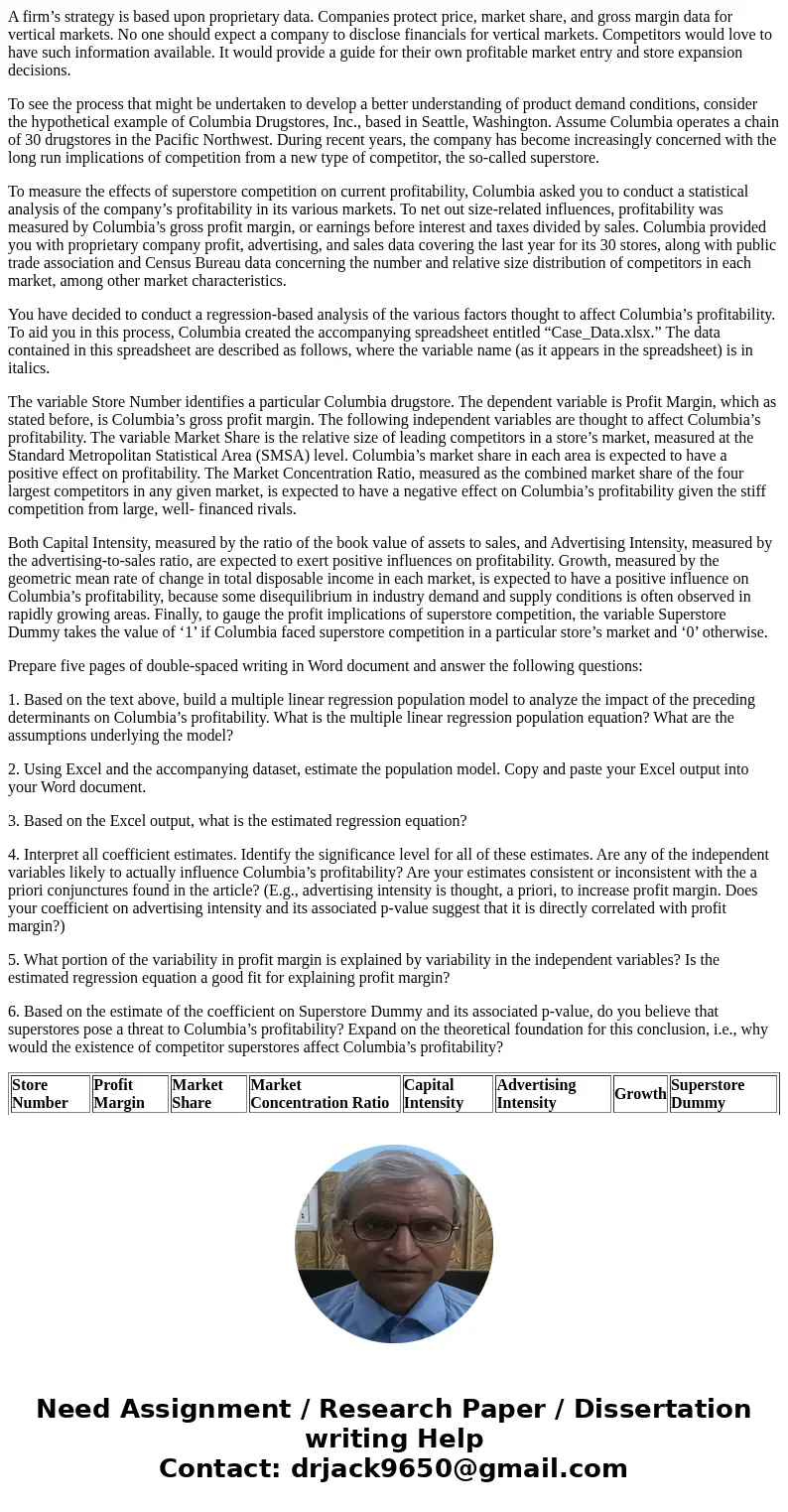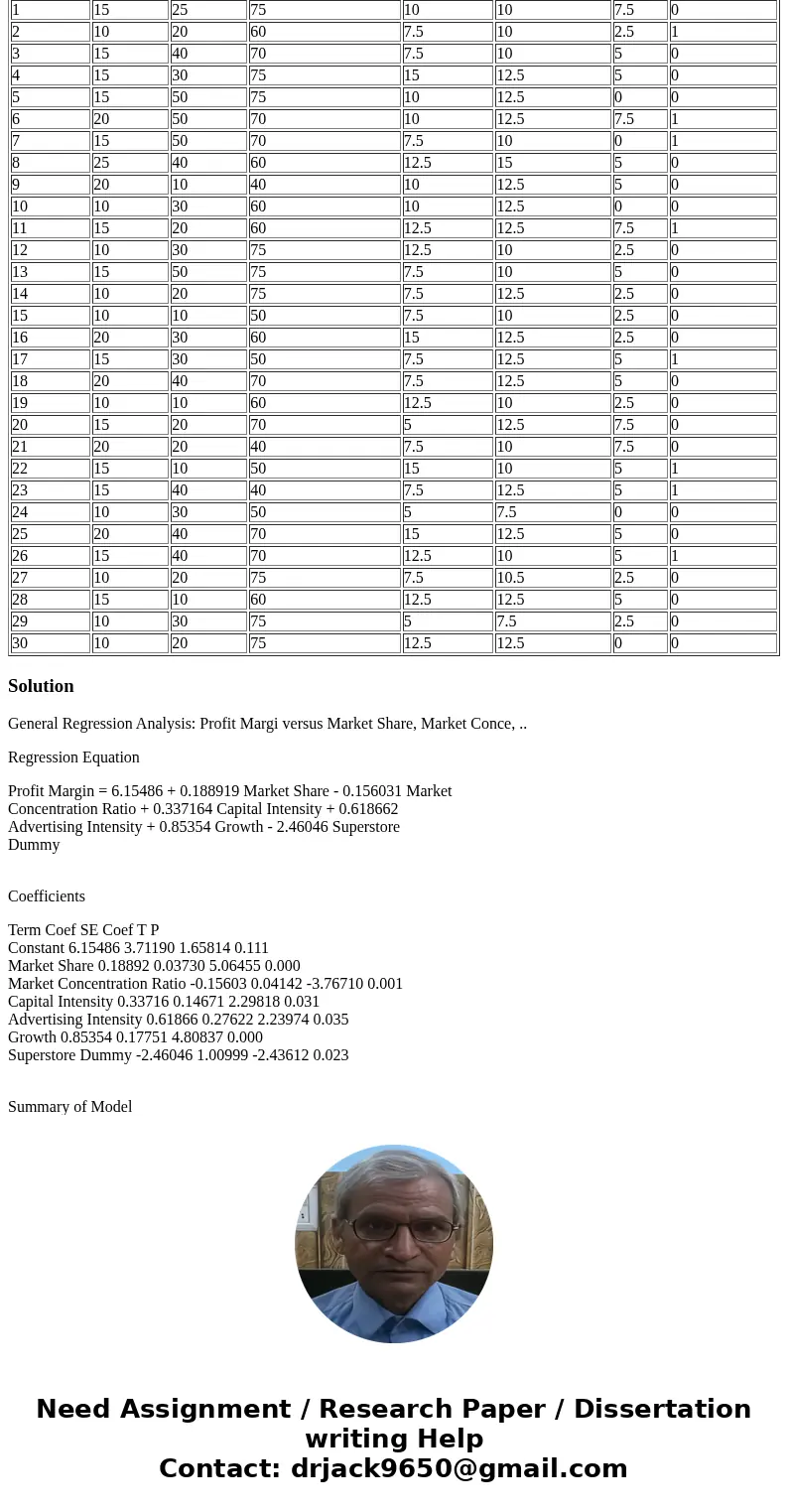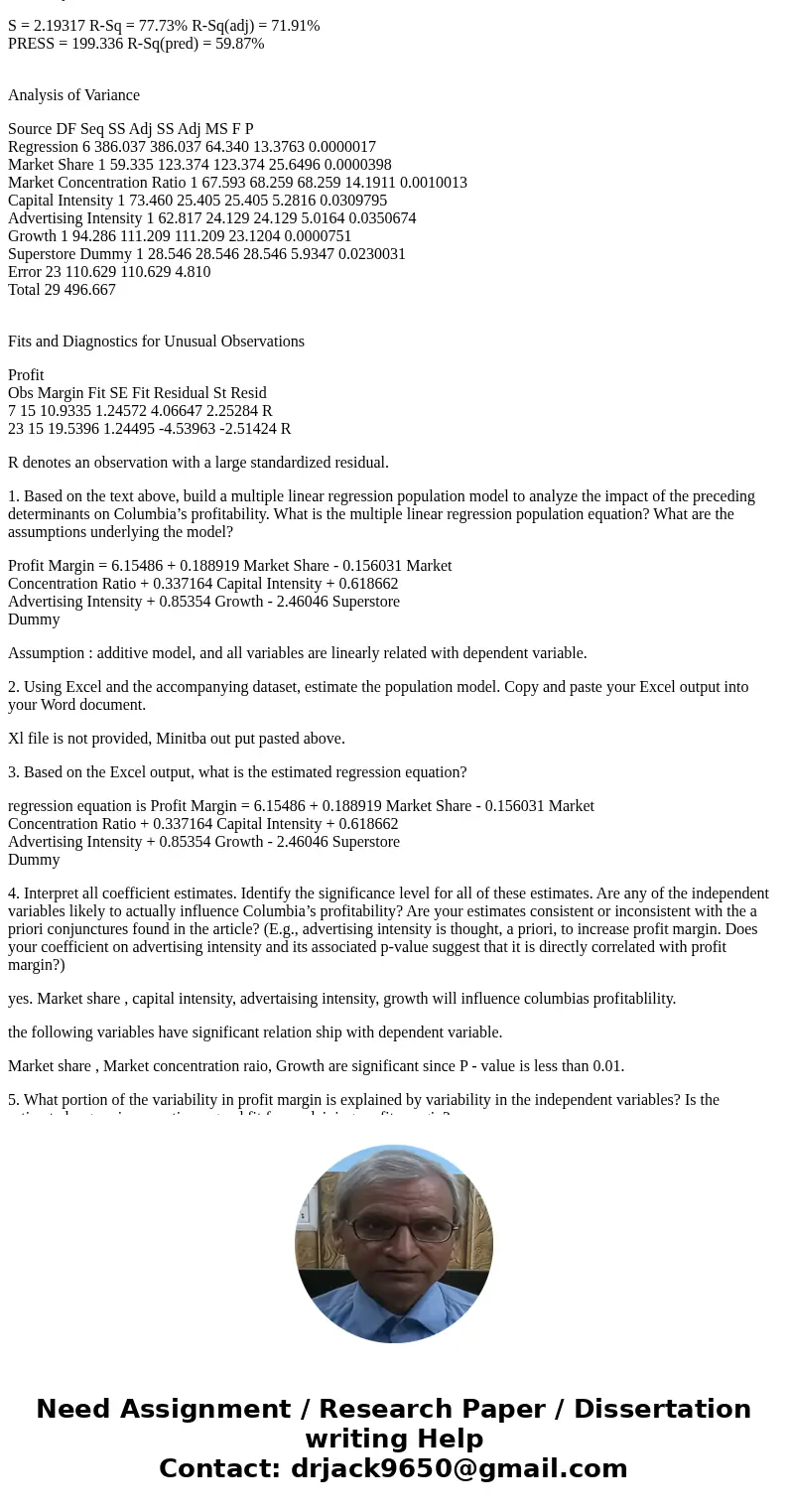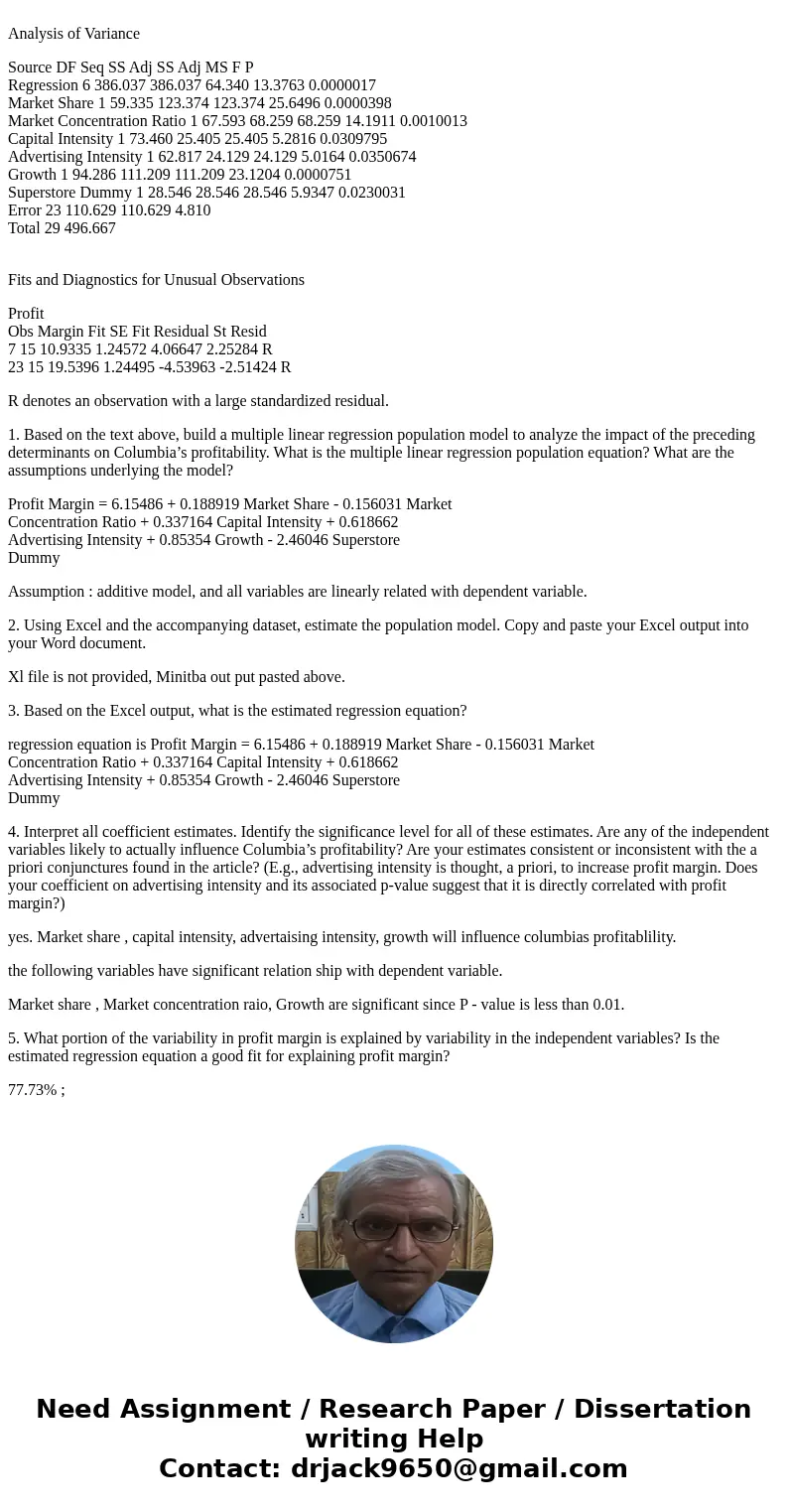A firms strategy is based upon proprietary data Companies pr
A firm’s strategy is based upon proprietary data. Companies protect price, market share, and gross margin data for vertical markets. No one should expect a company to disclose financials for vertical markets. Competitors would love to have such information available. It would provide a guide for their own profitable market entry and store expansion decisions.
To see the process that might be undertaken to develop a better understanding of product demand conditions, consider the hypothetical example of Columbia Drugstores, Inc., based in Seattle, Washington. Assume Columbia operates a chain of 30 drugstores in the Pacific Northwest. During recent years, the company has become increasingly concerned with the long run implications of competition from a new type of competitor, the so-called superstore.
To measure the effects of superstore competition on current profitability, Columbia asked you to conduct a statistical analysis of the company’s profitability in its various markets. To net out size-related influences, profitability was measured by Columbia’s gross profit margin, or earnings before interest and taxes divided by sales. Columbia provided you with proprietary company profit, advertising, and sales data covering the last year for its 30 stores, along with public trade association and Census Bureau data concerning the number and relative size distribution of competitors in each market, among other market characteristics.
You have decided to conduct a regression-based analysis of the various factors thought to affect Columbia’s profitability. To aid you in this process, Columbia created the accompanying spreadsheet entitled “Case_Data.xlsx.” The data contained in this spreadsheet are described as follows, where the variable name (as it appears in the spreadsheet) is in italics.
The variable Store Number identifies a particular Columbia drugstore. The dependent variable is Profit Margin, which as stated before, is Columbia’s gross profit margin. The following independent variables are thought to affect Columbia’s profitability. The variable Market Share is the relative size of leading competitors in a store’s market, measured at the Standard Metropolitan Statistical Area (SMSA) level. Columbia’s market share in each area is expected to have a positive effect on profitability. The Market Concentration Ratio, measured as the combined market share of the four largest competitors in any given market, is expected to have a negative effect on Columbia’s profitability given the stiff competition from large, well- financed rivals.
Both Capital Intensity, measured by the ratio of the book value of assets to sales, and Advertising Intensity, measured by the advertising-to-sales ratio, are expected to exert positive influences on profitability. Growth, measured by the geometric mean rate of change in total disposable income in each market, is expected to have a positive influence on Columbia’s profitability, because some disequilibrium in industry demand and supply conditions is often observed in rapidly growing areas. Finally, to gauge the profit implications of superstore competition, the variable Superstore Dummy takes the value of ‘1’ if Columbia faced superstore competition in a particular store’s market and ‘0’ otherwise.
Prepare five pages of double-spaced writing in Word document and answer the following questions:
1. Based on the text above, build a multiple linear regression population model to analyze the impact of the preceding determinants on Columbia’s profitability. What is the multiple linear regression population equation? What are the assumptions underlying the model?
2. Using Excel and the accompanying dataset, estimate the population model. Copy and paste your Excel output into your Word document.
3. Based on the Excel output, what is the estimated regression equation?
4. Interpret all coefficient estimates. Identify the significance level for all of these estimates. Are any of the independent variables likely to actually influence Columbia’s profitability? Are your estimates consistent or inconsistent with the a priori conjunctures found in the article? (E.g., advertising intensity is thought, a priori, to increase profit margin. Does your coefficient on advertising intensity and its associated p-value suggest that it is directly correlated with profit margin?)
5. What portion of the variability in profit margin is explained by variability in the independent variables? Is the estimated regression equation a good fit for explaining profit margin?
6. Based on the estimate of the coefficient on Superstore Dummy and its associated p-value, do you believe that superstores pose a threat to Columbia’s profitability? Expand on the theoretical foundation for this conclusion, i.e., why would the existence of competitor superstores affect Columbia’s profitability?
| Store Number | Profit Margin | Market Share | Market Concentration Ratio | Capital Intensity | Advertising Intensity | Growth | Superstore Dummy |
| 1 | 15 | 25 | 75 | 10 | 10 | 7.5 | 0 |
| 2 | 10 | 20 | 60 | 7.5 | 10 | 2.5 | 1 |
| 3 | 15 | 40 | 70 | 7.5 | 10 | 5 | 0 |
| 4 | 15 | 30 | 75 | 15 | 12.5 | 5 | 0 |
| 5 | 15 | 50 | 75 | 10 | 12.5 | 0 | 0 |
| 6 | 20 | 50 | 70 | 10 | 12.5 | 7.5 | 1 |
| 7 | 15 | 50 | 70 | 7.5 | 10 | 0 | 1 |
| 8 | 25 | 40 | 60 | 12.5 | 15 | 5 | 0 |
| 9 | 20 | 10 | 40 | 10 | 12.5 | 5 | 0 |
| 10 | 10 | 30 | 60 | 10 | 12.5 | 0 | 0 |
| 11 | 15 | 20 | 60 | 12.5 | 12.5 | 7.5 | 1 |
| 12 | 10 | 30 | 75 | 12.5 | 10 | 2.5 | 0 |
| 13 | 15 | 50 | 75 | 7.5 | 10 | 5 | 0 |
| 14 | 10 | 20 | 75 | 7.5 | 12.5 | 2.5 | 0 |
| 15 | 10 | 10 | 50 | 7.5 | 10 | 2.5 | 0 |
| 16 | 20 | 30 | 60 | 15 | 12.5 | 2.5 | 0 |
| 17 | 15 | 30 | 50 | 7.5 | 12.5 | 5 | 1 |
| 18 | 20 | 40 | 70 | 7.5 | 12.5 | 5 | 0 |
| 19 | 10 | 10 | 60 | 12.5 | 10 | 2.5 | 0 |
| 20 | 15 | 20 | 70 | 5 | 12.5 | 7.5 | 0 |
| 21 | 20 | 20 | 40 | 7.5 | 10 | 7.5 | 0 |
| 22 | 15 | 10 | 50 | 15 | 10 | 5 | 1 |
| 23 | 15 | 40 | 40 | 7.5 | 12.5 | 5 | 1 |
| 24 | 10 | 30 | 50 | 5 | 7.5 | 0 | 0 |
| 25 | 20 | 40 | 70 | 15 | 12.5 | 5 | 0 |
| 26 | 15 | 40 | 70 | 12.5 | 10 | 5 | 1 |
| 27 | 10 | 20 | 75 | 7.5 | 10.5 | 2.5 | 0 |
| 28 | 15 | 10 | 60 | 12.5 | 12.5 | 5 | 0 |
| 29 | 10 | 30 | 75 | 5 | 7.5 | 2.5 | 0 |
| 30 | 10 | 20 | 75 | 12.5 | 12.5 | 0 | 0 |
Solution
General Regression Analysis: Profit Margi versus Market Share, Market Conce, ..
Regression Equation
Profit Margin = 6.15486 + 0.188919 Market Share - 0.156031 Market
Concentration Ratio + 0.337164 Capital Intensity + 0.618662
Advertising Intensity + 0.85354 Growth - 2.46046 Superstore
Dummy
Coefficients
Term Coef SE Coef T P
Constant 6.15486 3.71190 1.65814 0.111
Market Share 0.18892 0.03730 5.06455 0.000
Market Concentration Ratio -0.15603 0.04142 -3.76710 0.001
Capital Intensity 0.33716 0.14671 2.29818 0.031
Advertising Intensity 0.61866 0.27622 2.23974 0.035
Growth 0.85354 0.17751 4.80837 0.000
Superstore Dummy -2.46046 1.00999 -2.43612 0.023
Summary of Model
S = 2.19317 R-Sq = 77.73% R-Sq(adj) = 71.91%
PRESS = 199.336 R-Sq(pred) = 59.87%
Analysis of Variance
Source DF Seq SS Adj SS Adj MS F P
Regression 6 386.037 386.037 64.340 13.3763 0.0000017
Market Share 1 59.335 123.374 123.374 25.6496 0.0000398
Market Concentration Ratio 1 67.593 68.259 68.259 14.1911 0.0010013
Capital Intensity 1 73.460 25.405 25.405 5.2816 0.0309795
Advertising Intensity 1 62.817 24.129 24.129 5.0164 0.0350674
Growth 1 94.286 111.209 111.209 23.1204 0.0000751
Superstore Dummy 1 28.546 28.546 28.546 5.9347 0.0230031
Error 23 110.629 110.629 4.810
Total 29 496.667
Fits and Diagnostics for Unusual Observations
Profit
Obs Margin Fit SE Fit Residual St Resid
7 15 10.9335 1.24572 4.06647 2.25284 R
23 15 19.5396 1.24495 -4.53963 -2.51424 R
R denotes an observation with a large standardized residual.
1. Based on the text above, build a multiple linear regression population model to analyze the impact of the preceding determinants on Columbia’s profitability. What is the multiple linear regression population equation? What are the assumptions underlying the model?
Profit Margin = 6.15486 + 0.188919 Market Share - 0.156031 Market
Concentration Ratio + 0.337164 Capital Intensity + 0.618662
Advertising Intensity + 0.85354 Growth - 2.46046 Superstore
Dummy
Assumption : additive model, and all variables are linearly related with dependent variable.
2. Using Excel and the accompanying dataset, estimate the population model. Copy and paste your Excel output into your Word document.
Xl file is not provided, Minitba out put pasted above.
3. Based on the Excel output, what is the estimated regression equation?
regression equation is Profit Margin = 6.15486 + 0.188919 Market Share - 0.156031 Market
Concentration Ratio + 0.337164 Capital Intensity + 0.618662
Advertising Intensity + 0.85354 Growth - 2.46046 Superstore
Dummy
4. Interpret all coefficient estimates. Identify the significance level for all of these estimates. Are any of the independent variables likely to actually influence Columbia’s profitability? Are your estimates consistent or inconsistent with the a priori conjunctures found in the article? (E.g., advertising intensity is thought, a priori, to increase profit margin. Does your coefficient on advertising intensity and its associated p-value suggest that it is directly correlated with profit margin?)
yes. Market share , capital intensity, advertaising intensity, growth will influence columbias profitablility.
the following variables have significant relation ship with dependent variable.
Market share , Market concentration raio, Growth are significant since P - value is less than 0.01.
5. What portion of the variability in profit margin is explained by variability in the independent variables? Is the estimated regression equation a good fit for explaining profit margin?
77.73% ;




 Homework Sourse
Homework Sourse